Introduction
Are you ready for more heavyweight droid action, with superclocked punches thrown around and more blood on the floor? It’s time for round two of our dual-core battle of the flagships. The Samsung Galaxy S II and the LG Optimus 2X are fully updated and ready to show their best. We’ve also thrown the Samsung Galaxy S Plus in the ring to see if one, faster core is better than two slower ones.
The first time around, we had a pre-release Galaxy S II on a 1GHz dual-core CPU and the Optimus 2X has since received a few firmware updates up to stock V10B, which made it noticeably zippier.
Not only that, but we also got the latest 1.2GHz Galaxy S II, we felt obligated to redo the tests now that we’ve got a final Galaxy S II with a 1.2GHz processor (updated to the I9100XWKE7 firmware). A Galaxy S Plus with a faster than usual single-core processor makes it a three-cornered fight.
Now, our Galaxy S Plus unit runs at just 1.2GHz instead of the 1.4GHz planned for the final version. Stil, we can’t wait to see if 2 x 1GHz is better than 1 x 1.2GHz – a 20% increase in clock speed should bring a big improvement in single-threaded tasks of which there are many, considering we’ve only recently entered the world of dual-core phones.




Samsung Galaxy S II official photos
Now, the Plus version could breathe new life into the old Galaxy S but it’s still using the old 5MP camera with “just” 720p video recording and the old PenTile SuperAMOLED screen.
The Samsung and LG flagships on the other hand boast 8MP cameras with 1080p video capture. And in the case of the Galaxy S II, the screen is a massive improvement.



LG Optimus 2X official photos
So, here’s what we’ll cover in this repeat head to head comparison.
For starters, we’ll look at the screens again but having seen the Galaxy S, S II and Optimus 2X last time there’s nothing really new to say here – the screens of the phones are exactly as before.
After that we’ll test the 8MP sharpshooters (the Galaxy S Plus need not apply) and see if the firmware changes affected the camera. Maybe improved bitrate for the video recording has allowed finer detail in the videos, we’ll have to check.
Then, we’ll be testing the processor and graphics performance – cutting edge CPUs and GPUs simply beg to be benchmarked. Browser performance is another topic we plan to cover – it’s taxing on the system (especially with Flash) and is used almost daily.
What else? Some real-life games, of course, we shouldn’t put too much trust in benchmarks. We’ll also want to try out the GPS capabilities of the phones – it’s got nothing to do with fast processors but flagships should be good at everything, right?
Well, let the tests begin. It’s about which one’s the best if money is no object and what the latest and greatest phones can deliver
SuperAMOLED, SuperAMOLED Plus and LCD
The original Galaxy S had an amazing display. But as great as the SuperAMOLED tech is, it did have its drawbacks, mainly the PenTile subpixel matrix. The Galaxy S Plus has the exact same display so that goes on its record too.The new generation SuperAMOLED Plus increases the size of the available panels up to 4.3”, it improves performance and it comes with a conventional subpixel matrix. We expect nothing but excellence – let’s see if the Samsung I9100 Galaxy S II delivers.
First, a few words on the PenTile matrix to give you an idea of what you’re looking at. PenTile uses only two subpixels per each pixel of the screen, unlike traditional matrices that use three (LCD displays use this arrangement too). The image below demonstrates the difference though in an exaggerated way.

Even though both the original Galaxy S and the Galaxy S II have equal resolution – WVGA, or 480 x 800 pixels, the use of a conventional matrix has given the SuperAMOLED Plus screen 50% more subpixels, making the display noticeably sharper (especially when it comes to small text).
Here are a few shots we took of the displays of the original Galaxy S, the Galaxy S II and the iPhone 4. You can see that the subpixels look as we expected them to.
The iPhone 4’s Retina display is easily the sharpest of the bunch. There is a very noticeable difference between the two Galaxies in the following extreme close-up shot, but in reality, the difference isn't that prominent, unless you’re looking at them from really close.


Macro shot of the screens of the Galaxy S II, the original Galaxy S (middle) and iPhone 4 (bottom)
Sharpness isn't a problem for the traditional LCD matrix of the LG Optimus 2X. The WVGA 4-incher gives the Optimus 2X the highest pixel density of the trio. That’s taking into account the subpixels, of course and not counting the iPhone 4, which isn't a part of this test.
The SuperAMOLED Plus display of the Galaxy S II has exceptional viewing angles but the old screen in the Samsung Galaxy S isn't half bad either. LCD units however, especially without IPS or similar enhancements, suffer a sharp decline color and contrast when viewed at an angle.
For this comparison we’ve put the first and second generation Galaxy S phones next to the LG Optimus 2X. The Galaxy S Plus uses the same screen as the I9000 Galaxy S, so the findings here are valid for it too.








LG Optimus 2X • Samsung I9100 Galaxy S II • Samsung I9000 Galaxy S
The new Super AMOLED Plus display reportedly has improved brightness and power efficiency. We were surprised however to see the SuperAMOLED Plus screen is no brighter than the previous generation used in the original Galaxy S.
Here are our measurements.
| Display test | 50% brightness | 100% brightness | ||
| Black, cd/m2 | White, cd/m2 | Black, cd/m2 | White, cd/m2 | |
| iPhone 3GS | 0.84 | 134 | 2.51 | 504 |
| iPhone 4 | 0.14 | 189 | 0.39 | 483 |
| Sony Ericsson XPERIA Arc | 0.03 | 34 | 0.33 | 394 |
| LG Optimus 2X | 0.23 | 228 | 0.35 | 347 |
| HTC Incredible S | 0.18 | 162 | 0.31 | 275 |
| Samsung I9100 Galaxy S II | 0 | 231 | 0 | 362 |
| Samsung Galaxy Ace | 0.23 | 160 | 0.34 | 234 |
| Sony Ericsson Xperia Neo | 0.05 | 68 | 0.10 | 134 |
You’ll notice we didn’t measure the contrast ratio of either SuperAMOLED display – that’s due to how OLED works. Contrast is the ratio of how bright a white pixel is compared to a black pixel while both are visible on the screen. Since black pixels in OLED type displays don’t emit any light at all, the contrast tends to infinity (which isn't really a meaningful comparison).
8MP sharpshooter challenge
We’ve covered the camera interface of all contenders and you can refer to their respective reviews for details on each.We will say a few words on the differences between Samsung and LG though, for the sake of comparison. Samsung’s solution did win us over with its customizable left taskbar – you choose which shortcuts you want and put them there.
In LG’s solution for example, you always have to go to the menu to toggle, say, macro. This gets annoying if you shoot a lot of macro shots – you have to turn it on from the menu and then remember to turn it off from there, instead of having the setting right on the screen.
The Samsung Galaxy S II also offered better shot to shot time – about a second, while the Optimus 2X takes over two seconds before it’s ready to snap another photo.
As for features to play with, both offer more dials, toggles and shooting modes than most users will use in practice. There’s face detection, smile detection, geotagging, image stabilization, panorama shots, color effects and so on.
Maybe you’ll use some of those, others just once for fun or not at all. Most of the time, you will be using auto mode so let’s see how the Samsung Galaxy S II and the LG Optimus 2X stack up in image quality. The Galaxy S Plus isn't included here since it’s just a 5MP snapper and it won’t be a fair comparison.
Both phones performed very well and produced photos the average user will be delighted with. The Samsung Galaxy S II kept the noise levels lower and had better white balance although it showed traces of oversharpening. The S II photos had better contrast.
The Optimus 2X oversharpened some edges as well. We liked its macro shots better than the ones from the S II. Overall it kept very close to the S II, although its higher noise levels and lower contrast put it in second place.
Here are the camera samples we snapped with both phones so you can compare them yourselves.










Samsung I9100 Galaxy S II camera samples










LG Optimus 2X camera samples
Photo quality comparison
The Samsung I9100 Galaxy S II and the LG Optimus 2X are already in our Photo Compare Tool database, but we’ve updated the samples using the latest firmware available for both phones.The Galaxy S II update was supposed to have fixed the pink spot issue, though we didn’t see a pink spot in the first place. Maybe it’s a problem that affects only some of the units.
Anyway, the S II camera doesn’t suffer any other camera issues. The low noise level is great too.
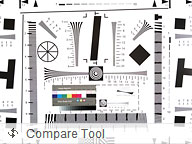


Samsung I9100 Galaxy S II in our Photo Compare Tool
After the update, the Optimus 2X seems to perform marginally better in our synthetic benchmarks. Noise reduction and the resolved detail in particular have improved a little.



LG Optimus 2X in our Photo Compare Tool
Through the camera lens: shooting 1080p video
Recording FullHD (1080p) video requires a lot of processing power – and storage. The easiest way to improve the quality of the video (or make it worse) is to change the frame rate.The Samsung I9100 Galaxy S II and the LG Optimus 2X both shoot 1080p videos, but take different routes. The S II uses MP4 encoding with 17-18Mbps while the 2X is still using 3GP and 10Mbps.
Now, MP4 is the better video container of the two and 18Mbps keeps more fine detail. Check out these crops from video frames taken from both phones. The Galaxy S II video frames are considerably sharper with much more resolved detail.
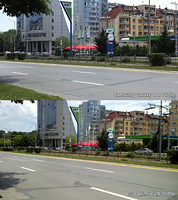
Crops from 1080p video
The Galaxy S II zooms in quite a lot when in 1080p mode (compared to the still camera or the video camera in 720p mode), so you might have to stand back. Also, both phones recorded mono audio at about 60Kbps, though the 2X used 22KHz while the S II used 16KHz sampling rate. Either way, the audio is less than perfect.
Image quality is only one part of the equation – frame rate is the other. If a video is below the magical 24fps it appears unacceptably choppy, while anything above that framerate is perceived as smooth motion by our eyes.
We’re pleased to report that both phones produced videos with smooth, consistent frame rate and didn’t duplicate any frames. Not that they are completely without issues though.
The Galaxy S II would start recording and only then try to find focus. It even looked for focus during recording (despite being held absolutely stationary), which was kind of annoying.
The Optimus 2X on the other hand had trouble with the exposition during capture (triggered by the differently colored cars passing in front of it) – look at how the sky “pulses”.
Here are untouched 1080p video samples from the Samsung Galaxy S II (0:09, 19.2MB) and from the LG Optimus 2X (0:10, 11.8MB).
Or you can check out these video samples we’ve uploaded to YouTube. Keep in mind that the extra bit of compression has taken its toll on the image quality. Don’t forget to choose the 1080p setting when you play the video.
720p video is HD too
Not everyone needs 1080p video, so we tested the Galaxy S II and the Optimus 2X in 720p mode. The S II drops the bitrate to around 12Mbps while the 2X goes under 5Mbps.The advantage in image quality is still in favor of the S II though the difference is not nearly as dramatic as before if we’re to trust these video frame crops.
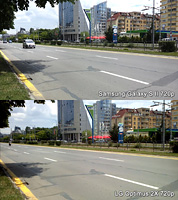
Frames from 720p video
The Optimus 2X has zooming enabled in both 1080p and 720p mode, while the Galaxy S II activates zoom only when you switch to 720p. Both phones do regular upsample zoom, there’s no pixel binning going on.
Here are video samples from the Samsung Galaxy S II and the LG Optimus 2X uploaded to YouTube.
Video quality comparison
We’ve updated the Video quality comparison entries for the Galaxy S II and the Optimus 2X as well.Individual frames from the Galaxy S II reveal that the video compression doesn’t result in many artifacts (compression-related or of any other origin). The actual resolution is notably higher than on the LG Optimus 2X.
However in low-light conditions the Galaxy S II resolution advantage quickly diminishes and its resolved detail is about the same as that on the Optimus 2X.


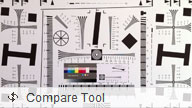
Samsung I9100 Galaxy S II in the Video Compare Tool



LG Optimus 2X in the Video Compare Tool
Synthetic benchmarks: more is better
The last time we put those two against each other both were running their CPUs at 1GHz. Now, we’ve got a finalized Samsung Galaxy S II with a 1.2GHz clock speed and we’ve updated the LG Optimus 2X to the V10B firmware to make use of any optimizations LG might have made since we last tested the 2X.Also, the Samsung Galaxy S Plus will show us if single-core CPUs are still worth it – 1.2GHz is pretty fast (the final version should be faster still) and it should have a 20% advantage in single-threaded benchmarks over the original Galaxy S and Optimus 2X, while lagging behind the dual-cores in multithreaded ones. Graphics is another thing to consider as you’ll see in a minute.
Let’s start with the dedicated CPU benchmarks. BenchmarkPi and Linpack both show an improvement of a little under 20% in performance between the LG Optimus 2X and the Samsung Galaxy S II (as expected). The Galaxy S Plus is a major improvement on the original, nearly reaching the scores of the S II in Linpack - so, the final 1.4GHz version should be top dog in this benchmark. The S II is still ahead by virtue of its newer architecture, while the original fails miserably here for some reason.
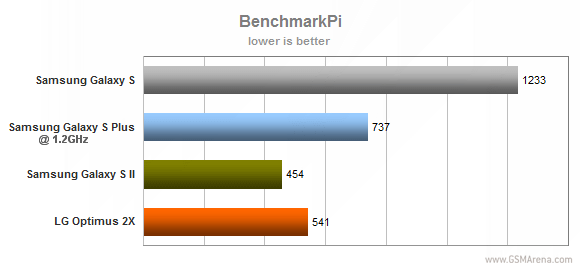
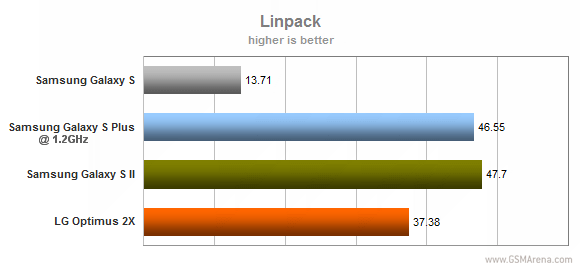
Quadrant and SmartBench 2011 Productivity show a big lead for the Galaxy S II too. Quadrant marks an improvement of over 20%, which we suspect has to do with the EXT4 file system used in Gingerbread. These two tests show that one fast core doesn’t quite cut it when it comes to general usage and the S Plus can’t touch the dual cores.
The Game test suit of SmartBench 2011 crowned the mobile GeForce as the champion with a comfortable advantage.
You’ll notice that the Adreno 205 in the S Plus actually does worse than the PowerVR SGX540 in the original Galaxy S, which (oddly) beats even the Galaxy S II. Running GLBenchmark however was pretty definitive – the frame rate was smooth on the S II, smoother than the original Galaxy S.
We couldn’t check the exact scores since the benchmark crashed at the end, but the difference in frame rate was readily apparent to the naked eye.
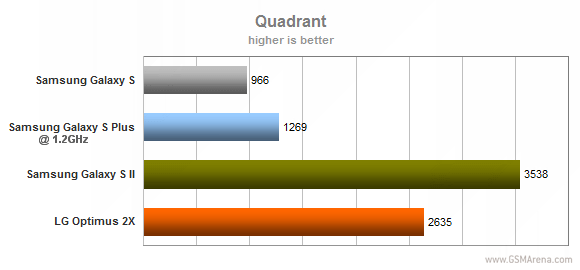
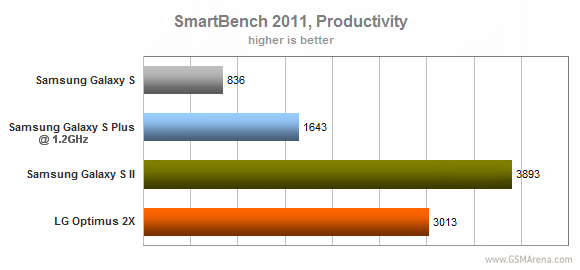
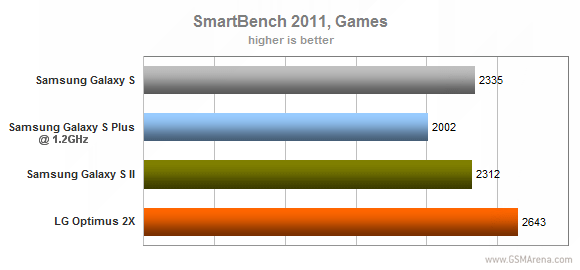
SunSpider is a JavaScript benchmark that focuses on pure script performance – that is no graphics, no changing anything on the web page, just calculations. Unsurprisingly, Galaxy S II has the lead here, but the Galaxy S Plus holds its own with only its older architecture holding it back, though an extra 200MHz clock speed will help it close the gap.
BrowserMark, which test both number crunching performance along with graphics and web page handling, puts Galaxy S II in the lead with the Optimus 2X a close second. The original Galaxy S lags behind while the S Plus shows decent improvement but doesn’t reach the dual-core levels of performance.
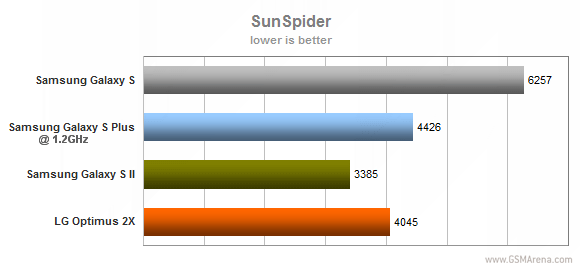
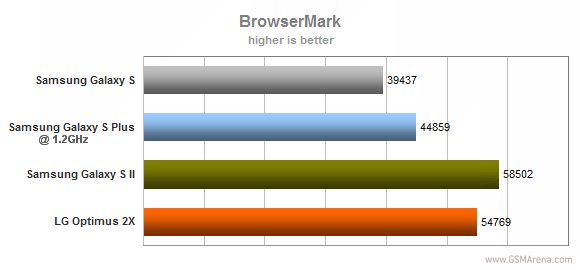
Testing web browsing performance
Dry specs and synthetic benchmarks aside, it’s the real-life performance that really matters to users.So we decided to put the dual-core phones toe to toe and use the Galaxy S Plus to represent the single-cores.
Before we continue we’d like you to keep in mind one thing – both Galaxy’s are running Android 2.3 Gingerbread, while the Optimus 2X is still stuck on Froyo 2.2. And that casts a shadow on its performance.
We hooked-up all three smartphones to the same Wi-Fi network and began our browser test. The Galaxy S II loaded fresh pages the fastest with the Optimus 2X following closely behind. The Galaxy S Plus almost kept up with their pace but it took a long time to show any content.
The S II and 2X would very quickly render most of the page and then gradually finish it, while the Plus would display a white, empty page most of the time and only render the page when done.
When loading a previously visited page, the S II browser was the fastest thanks to its better caching, while the 2X and Plus browser had to reload basically the whole page.



Browsers head to head: Galaxy S II • Galaxy S Plus • Optimus 2X
Panning is smoother in the Galaxy S II and as is zooming, though the Optimus 2X redraws the page as you zoom, while the S II upsamples the rendered page and only redraws it once you stop zooming. Even the Galaxy S Plus felt smoother than the 2X, almost as good as the S II.
Flash performance is incomparable – the Optimus 2X does okay with 360p YouTube videos but gets terribly choppy at 720p. The Galaxy S II on the other hand played 1080p videos no problem. This is probably down to software rather than pure hardware performance, but the S II handles flash much better than the 2X and there’s no way around that.
As for the Galaxy S Plus, it played 720p YouTube videos just fine (the original can too) though 1080p proved too much for the overclocked chipset. It wouldn't have made a difference even if it was running at 1.4GHz instead of just 1.2GHz - the lag was simply too great.



Playing YouTube video: Galaxy S II • Galaxy S Plus • Optimus 2X
As for Flash games, most ran quite smoothly although there were a few that lagged quite a bit on the Optimus 2X while they ran smoothly on the Galaxy S II and Galaxy S Plus.
We tried updating the Flash Player to version 10.3 on the Optimus 2X (the V10B firmware comes with v10.1) but that didn’t fix the performance woes.
We’ve prepared a short video comparison of web browsing the two dual-core smartphones: the Galaxy S II and the Optimus 2X.
Mobile gaming performance
While looking for a game stressful enough to test our trio of droids we found out that the majority of games require much weaker hardware (to support the majority of Android phones out there) and we couldn’t really find a game that would push either of our phones to its limits.


Shrek Karting: Galaxy S II • Galaxy S Plus • Optimus 2X
On the upside that means that there are no games out there for Android that you can’t play. The Galaxy S II loaded games a little faster than the other two, which finished basically simultaneously. That’s probably due to the higher amount of RAM in the S II.



AirAttack HD: Galaxy S II • Galaxy S Plus • Optimus 2X
Other than that, games ran equally well on the three phones. We shot a short video showing Shrek Karting and AirAttack HD.
GPS accuracy test
Satellite navigation is becoming very common use for smartphones, so we put our droid trio to the test. Using an app, we cleared their A-GPS data so they start fresh and we looked at how fast they got a lock and how accurate it was.All three got their satellite lock in about a minute so there’s no clear winner here (a few seconds of difference don’t really matter).
The LG Optimus 2X was the clear winner of the test – it reported between 6 and 8 satellites in view, used 6 of them and reported accuracy of 5m. Now, reported accuracy is probably off real-world accuracy but the reports were consistent.
Surprisingly, the Samsung Galaxy S Plus beat out the S II flagship to come in second. It read 7 satellites in the sky and used 5-7 of those (you need a minimum of 4, but the more you use, the more accurate the positioning). Accuracy hovered around the 12-15m mark, though at times it fell as low as 5m.
Finally, the Galaxy S II saw up to 8 satellites and used 7 of them most of the time but its reported accuracy was pretty poor – it stayed around 25m most of the time, dipping to around 6m for short periods of time.
The S II claimed GPS lock even indoors (a couple of meters away from a window), with reported accuracy of about 50m and 6 satellites in use. The other two reported lock at first but lost it, even though they were still reading some satellites.
Final words
All three droids performed admirably in our tests and they helped us make two things clear – you can’t beat the performance of modern dual-core CPUs by just overclocking an old chipset. On the other hand, an overclocked single-core chipset is powerful enough for almost everyone.The Samsung Galaxy S II came out on top most often – not always by a lot, but it does seem like the winner in our tests. The big lead in Flash performance and the better 1080p videos give it a definite edge, while the 4.3” SuperAMOLED Plus display is miles ahead of any regular LCD and it seals the deal.
Not that it can’t learn a thing or two from the LG Optimus 2X – especially when it came to graphics (in benchmarks anyway) and reliable GPS performance. The still camera offered very solid performance and the video camera is still better than most on the market.
As for the Samsung Galaxy S Plus, it’s a solid overhaul. The original was an excellent phone and this boost in performance is a welcome lifeline. As long as it’s priced reasonably below the S II of course, which makes even the updated model seem slow and chubby.
It’s clear that dual-cores are the way of the future, but Android’s diverse nature means that devs have to support devices with much lower resources, so most things don’t even come close to pushing a dual-core chipset to its limit.
But grab a Galaxy S II or an Optimus 2X and you’ll be able to run everything in the Android Market in the near future. There’s a sizable price gap between the two models right now, but whichever way you go, you’ll get your money’s worth.
No comments:
Post a Comment